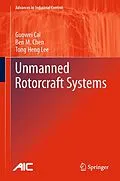Unmanned Rotorcraft Systems explores the research and development of fully-functional miniature rotorcraft unmanned aerial vehicles (UAV), and provides a complete treatment of their design. The unmanned system is an integration of advanced technologies developed in communications, computing, and control areas. It is a useful testing ground for trialing and implementing modern control techniques despite the challenges introduced by the limitations on direct scalability between the systems of a small-scale rotorcraft and those of its full-scale counterpart. Included are detailed expositions of:
- systematic hardware construction;
- software systems integration;
- aerodynamic modeling; and
- automatic flight control system design.
Emphasis is placed on the cooperative control and flight formation of multiple UAVs, vision-based ground-target tracking, and landing on moving platforms. Other issues such as the development of indoor micro aerial vehicles (that have to operate without access to a global positioning system) and vision-based navigation are also discussed in depth. The text is rounded out with a presentation of possible future research directions for relevant fields of study.
Unmanned Rotorcraft Systems will be of great value to practicing engineers in aerospace-related industries and to academic researchers from aerospace, electrical or mechanical engineering backgrounds working on the development of unmanned systems.
Autorentext
Guowei Cai's research area is the development of unmanned aerial systems, aerodynamic modeling and flight control systems.
Ben M. Chen's research areas include the development of unmanned systems, robust and non-linear control, and systems theory and control applications.
Tong H. Lee's main research foci are in unmanned aerial systems, adaptive control systems, knowledge-based control and intelligent motion control.
Klappentext
Unmanned Rotorcraft Systems explores the research and development of fully-functional miniature rotorcraft unmanned aerial vehicles (UAV), and provides a complete treatment of their design. The unmanned system is an integration of advanced technologies developed in communications, computing, and control areas. It is a useful testing ground for trialing and implementing modern control techniques despite the challenges introduced by the limitations on direct scalability between the systems of a small-scale rotorcraft and those of its full-scale counterpart. Included are detailed expositions of:
- systematic hardware construction;
- software systems integration;
- aerodynamic modeling; and
- automatic flight control system design.
Emphasis is placed on the cooperative control and flight formation of multiple UAVs, vision-based ground-target tracking, and landing on moving platforms. Other issues such as the development of indoor micro aerial vehicles (that have to operate without access to a global positioning system) and vision-based navigation are also discussed in depth. The text is rounded out with a presentation of possible future research directions for relevant fields of study.
Unmanned Rotorcraft Systems will be of great value to practicing engineers in aerospace-related industries and to academic researchers from aerospace, electrical or mechanical engineering backgrounds working on the development of unmanned systems.
Inhalt
Introduction.- Systematic Hardware construction.- Software System Integration.- Aerodynamic Modeling and System Identification.- Measurement Signal Enhancement.- Automatic Flight Control.- Flight Simulation and Experiment.- Cooperative Control of Multiple Rotorcraft.- Vision-based Tracking and Landing.- Micro Aerial Vehicles.- Future Research.
